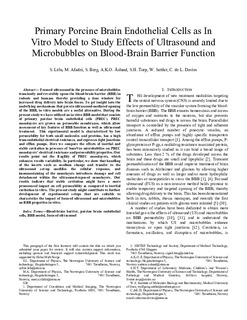| dc.contributor.author | Lelu, Sylvie | |
| dc.contributor.author | Afadzi, Mercy | |
| dc.contributor.author | Berg, Sigrid | |
| dc.contributor.author | Åslund, Andreas | |
| dc.contributor.author | Torp, Sverre Helge | |
| dc.contributor.author | Sattler, Wolfgang | |
| dc.contributor.author | Davies, Ruth Catharina de Lange | |
| dc.date.accessioned | 2019-02-28T13:09:12Z | |
| dc.date.available | 2019-02-28T13:09:12Z | |
| dc.date.created | 2017-01-18T13:07:18Z | |
| dc.date.issued | 2017 | |
| dc.identifier.citation | IEEE Transactions on Ultrasonics, Ferroelectrics and Frequency Control. 2017, 64 (1), 281-290. | nb_NO |
| dc.identifier.issn | 0885-3010 | |
| dc.identifier.uri | http://hdl.handle.net/11250/2588078 | |
| dc.description.abstract | Focused ultrasound (FUS) in the presence of microbubbles transiently and reversibly opens the blood-brain barrier (BBB) in rodents and humans, thereby providing a time window for increased drug delivery into brain tissue. To get insight into the underlying mechanisms that govern ultrasound (US)-mediated opening of the BBB, in vitro models are a useful alternative. In this paper, we have utilized an in vitro BBB model that consists of primary porcine brain endothelial cells (PBECs). PBEC monolayers are grown on permeable membranes, which allow assessment of key features of BBB function as well as US treatment. This experimental model is characterized by low permeability for both small molecules and proteins, has a high transendothelial electrical resistance, and expresses tight junctions and efflux pumps. Here, we compare the effects of inertial and stable cavitation in the presence of SonoVue microbubbles on PBEC monolayers' electrical resistance and permeability properties. Our results point out the fragility of PBEC monolayers, which enhances results variability. In particular, we show that handling of the inserts, such as medium change and transfer to the US setup, modifies the cellular response, and immunostaining of the monolayers introduces damage and cell detachment within the US-exposed monolayers. Our results indicate that stable cavitation might have a more pronounced impact on cell permeability as compared with inertial cavitation in vitro. This paper might contribute to further development of experimental setups that are suitable to characterize the impact of FUS and microbubbles on BBB properties in vitro. | nb_NO |
| dc.language.iso | eng | nb_NO |
| dc.title | Primary Porcine Brain Endothelial Cells as In Vitro Model to Study Effects of Ultrasound and Microbubbles on Blood-Brain Barrier Function | nb_NO |
| dc.type | Journal article | nb_NO |
| dc.type | Peer reviewed | nb_NO |
| dc.description.version | acceptedVersion | nb_NO |
| dc.source.pagenumber | 281-290 | nb_NO |
| dc.source.volume | 64 | nb_NO |
| dc.source.journal | IEEE Transactions on Ultrasonics, Ferroelectrics and Frequency Control | nb_NO |
| dc.source.issue | 1 | nb_NO |
| dc.identifier.doi | 10.1109/TUFFC.2016.2597004 | |
| dc.identifier.cristin | 1430805 | |
| dc.relation.project | Norges forskningsråd: 240316 | nb_NO |
| dc.relation.project | Norges forskningsråd: 220005 | nb_NO |
| cristin.unitcode | 7401,60,45,0 | |
| cristin.unitname | Medisinsk teknologi | |
| cristin.ispublished | true | |
| cristin.fulltext | postprint | |
| cristin.qualitycode | 1 | |
